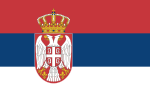List of Serbian mottos
Appearance
The following is a list of mottos connected to Serbia and Serbs. Serbia has no official national motto.
Mottos
[edit]- "Only Unity Saves the Serbs" (Само слога Србина спасава / Samo sloga Srbina spasava), unofficial Serbian national motto; interpretation of what is taken to be four Cyrillic letters for "S" (written С) on the Serbian cross.[1]
- "For Freedom and Honour of the Fatherland" (За слободу и част Отаџбине / Za slobodu i čast Otadžbine), motto of the Serbian Armed Forces, found on uniforms as well as on brigade flags.
Historical mottos
[edit]- "For the Honored Cross and Golden Liberty" (За крст часни и слободу златну / Za krst časni i slobodu zlatnu).[2]
- "With God, for Faith and Fatherland" (С Богом, за веру и отечество / S Bogom, za veru i otečestvo), motto of the Serbian Revolutionary Army.
- "Time and my right" (Време и моје право / Vreme i moje pravo), motto of the Obrenović dynasty.[3]
- "All for Serbdom and the Fatherland" (Све за Српство и отаџбину / Sve za Srpstvo i otadžbinu), motto of Narodna Odbrana.[4]
- "Liberty or Death" (Слобода или смрт / Sloboda ili smrt), motto of the Chetniks.[5]
- "For King and Fatherland" (За краља и отачаствo / Za kralja i otačastvo), motto of the Royal Serbian Army, found on regimental infantry flags.[6]
- "For the Faith, King and Fatherland" (За веру, краља и отачаство / Za veru, kralja i otačastvo), motto of the Royal Serbian Army, found on regimental cavalry flags.[7]
- "For King and Fatherland, with Faith in God" (С вером у Бога, за краља и отаџбину / S verom u Boga, za kralja i otadžbinu), motto of the Royal Serbian Army (during World War I) and Chetniks (during World War II).[8][9][10][11]
Slogans
[edit]- "Kosovo is Serbia" (Косово је Србија / Kosovo je Srbija), slogan and catch-phrase used in Serbia since Kosovo's 2008 declaration of independence.
- "Serbia to Tokyo" (Србија до Токија / Srbija do Tokija), slogan and catch-phrase used by both Serbian nationalists (to taunt rival neighbouring ethnic groups) and Serbs (jokingly mocking Serb exceptionalism) alike.
Gallery
[edit]-
Flag of the Serbian Revolutionary Army with motto "With God, for Faith and Fatherland"
-
Regimental flags of the Royal Serbian Army with motto "For King and Fatherland, with Faith in God"
-
Flag of Chetniks with motto "For Crown and Fatherland; Liberty or Death"
-
Flag of the Serbian Armed Forces with motto "For Liberty and Honour of the Fatherland"
See also
[edit]References
[edit]- ^ Ivan Čolović (January 2002). The Politics of Symbol in Serbia: Essays in Political Anthropology. C. Hurst & Co. p. 299. ISBN 978-1-85065-556-5.
- ^ Nikolaj Velimirović; Lj Ranković (1996). Izabrana dela u 10 knjiga: Ustanak robova. Srbija u svetlosti i mraku. O istoriji. Duhovni preporod Evrope. O Evropi. Agonija crkve. O zapadnom hrišćanstvu. Glas crkve. pp. 54, 57.
- ^ "Heraldry". www.royalhouseofobrenovic.org. Retrieved 2019-09-27.
- ^ Joll, James; Martel, Gordon (2013) [1984]. The Origins of the First World War (3rd ed.). Routledge. p. 113. ISBN 978-1-317-87536-9.
- ^ Heroes of the resistance. Dodd, Mead. 1967. p. 96.
- ^ MO SCG 2007, p. 72.
- ^ MO SCG 2007, p. 71.
- ^ Nigel Thomas; Dusan Babac (20 May 2012). Armies in the Balkans 1914-18. Osprey Publishing. p. 11. ISBN 978-1-78096-735-6.
- ^ Branko Latas; Milovan Dželebdžić (1979). Četnički pokret Draže Mihailovića 1941-1945. Beogradski izdavačko-grafički zavod. p. 40.
- ^ Ranko Pejić (1998). Srbi na Ozrenu i Vozući: život i stradanja. IPA "Miroslav". p. 229. ISBN 9788682487302.
- ^ Toward Freedom. Vol. 40–42. Toward Freedom. 1991. p. 3.
an old Chetnik slogan: "Believing in God for King and Fatherland."
Sources
[edit]- MO SCG (2007). "Odbrana". Odbrana: Magazin Ministarstva Odbrane SCG. 3–4 (53–58). Novinsko-izdavački centar "Vojska": 71–72.
- Samardžić, Dragana (1993). Старе заставе у Војном Музеју. Vojni muzej.
- Samardžić, Dragana (1983). Vojne zastave Srba do 1918. Belgrade: Vojni muzej.





